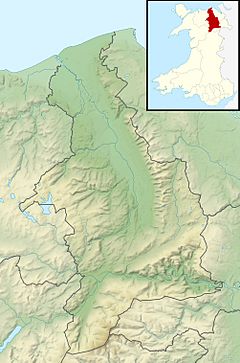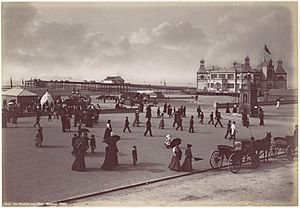Rhyl Pier facts for kids
 |
|
| Type | Pleasure |
|---|---|
| Carries | Pedestrians |
| Locale | Rhyl |
| Design | James Brunlees |
| Total length | 2,355 feet (718 m) |
| Opening date | 19 August 1867 |
| Destruction date | 1966 |
| Coordinates | 53°19′25″N 3°29′32″W / 53.32355°N 3.49211°W |
Rhyl Pier, officially known as the Victoria Pier, was a pleasure pier in the seaside town of Rhyl, Wales and the first to be built in North Wales. Opened in August 1867 at a length of over half a mile, it was the town's central attraction for the years that followed. Following dispute and public consultation regarding the location it would be built, the pier was constructed near the centre of the esplanade.
Several disasters occurred during the pier's lifespan, in particular several incidents during the late 19th century of boats crashing into the pier. In 1897, celebrity diver Tommy Burns fatally dived 100 feet (30 m) off the pier, observed by around 3000 people, before being declared dead shortly after being brought out of the sea.
The pier's Grand Pavilion, built in 1891, featured the world's largest organ, known as the Grand Jubilee Organ and weighed 25 tonnes (28 short tons). Following years of dereliction, the pier was purchased by Rhyl Council during the 1920s and was operational from the 1930s until the mid-1960s, at which point it was declared unsafe, closed and ultimately demolished in 1973.
Location
The pier was sited on the East Parade, directly opposite Church Street. At the shore end was a Grand Pavilion and Toll Houses. An additional Bijou Pavilion stood just off the shore. Original intentions where for the pier to be built at Kinmel Bay (then known as Foryd), with board members suggesting this location would also facilitate cattle transport as well as a tourist attraction. The decision to build to pier near the centre of the esplanade was reached following disputes and arguments with The Victoria Pier Company and following community consultation. The pier company chairman, Commissioner John Churton, suggested that a pier built near the town centre, as opposed to Foryd, would require costs of around £25,000 (equivalent to £2,548,100 in 2019) compared to £15,000 (equivalent to £1,528,800 in 2019) for a pier at Foryd.
History
Planning
A pier in Rhyl was first proposed during the mid-19th century, when the arrival of the Chester and Holyhead Railway in 1848 helped promote Rhyl as a popular seaside resort. Steamboats bringing visitors to Rhyl needed to use the Vordy Harbour, although this was not always available depending upon the tides. In 1862, the Rhyl Promenade Pier and Assembly Room Company (shortly after renamed to the Rhyl Promenade Pier Company) was formed with the purpose of providing a pier and landing stage for steamers on the promenade. The proposal for a cattle-traffic pier to be built in the west end of the town was passed, when it dawned on many board members that instead of pleasure boat traffic, there would be cattle boat traffic that could potentially block the port. Petitions and passionate speeches by Lord Richard Grosvenor and Richard Rowley MP helped get the bill thrown out. Residents of Rhyl claimed the pier scheme had been "forced upon them", which was a similar conclusion Lord Grosvenor determined when he ascertained the extent of local support, suggesting local people felt the original pier proposal "would be of no use to them".
After revised plans were put to the board, a public meeting was held to ascertain the feelings of the local population and determine support for a new pier near the town centre. The community response was generally in support for a pier at the centre of the esplanade. On 10 October 1863, the foreshore for the site of the proposed pier was leased by the Crown, with a provisional order for construction granted in January 1864 and Royal Assent gained later that year.
Due to conditions of the tide, a longer pier was deemed necessary to allow steamers to call at low tide. James Brunlees, an engineer who had designed Southport Pier, drew up plans to construct a 3,168 feet (966 m) long pier, to consist of cast iron piles with wooden decking. The pier would be 11 feet (3.4 m) above the high-water level and 16 feet (4.9 m) wide, with seats and shelters running the length of both sides.
Construction
The first foundation stone was laid on 25 May 1866 by Peter Ellis Eyton MP. By September 1866, 1,500 feet (460 m) of pier had been built until a storm on 11 September 1866 destroyed around 900 feet (270 m). The engineer, James Brunlees, was blamed for design faults and was replaced by R. D. Morgan, who redesigned the pier to be a further 7 feet (2.1 m) taller, albeit at a shorter overall length of 2,250 feet (690 m). The shorter length meant that steamboats would only be able to visit during medium and high tides.
During construction, the initial part of the structure was washed away by rough sea conditions.
Operation
The Victoria Pier opened on 19th August 1867 at a length of around 2,355 feet (718 m) and cost around £15,000 (equivalent to £1,528,800 in 2019). Crowds from as far as Liverpool and Manchester gathered for the opening, as well as visitors from local districts, to see the pier officially opened. A steamboat named Columbus was docked just off-shore and fired cannons at intervals. It was the first pier to be built in North Wales and became a productive asset to Rhyl, with excursions from Liverpool and other Welsh seaside resorts.
The pier was purchased in 1891 by the Rhyl Pier and Pavilion Company, who in June 1891 starting work on building a Grand Pavilion at the entrance. Original designs featured a large dome that ultimately was never constructed. The new Grand Pavilion was opened on 12 September 1891 by Lady Fiorentia Hughes, having taken just 14 weeks to erect and capable of holding around 3000 people. At the time, the pavilion featured the world's largest organ, known as the Grand Jubilee Organ, at a weight of 25 tons and complete with 3095 pipes. The new additions to the pier cost around £6,000 (equivalent to £683,900 in 2019).
A lifeguard station was added in 1893. In 1898, early film maker Arthur Cheetham presented his 'living pictures' to a full audience in the Grand Pavilion. By 1899, pier attractions included a water carnival, diving competitions and greasy poll walking.
Decline
Following storm damage, by 1913 the pier was declared unsafe and listed for sale. After no bids were made and in a derelict state, Rhyl Urban District Council purchased the pier in the 1920s for £1,000 (equivalent to £102,900 in 2019). Despite reopening in 1930 following redevelopment of the shore end and demolition of the seaward section, the pier subsequently closed in 1966 on safety grounds, at that time measuring just 330 feet (100 m) in length. It was demolished in March 1973.
Disasters
Several boats crashed in to the pier during its early existence. In December 1883, a schooner crashed into the pier during a gale, taking with it 120–150 feet (37–46 m) of pier. The following year, a steamboat also crashed into the pier during a storm.
During work to build a large pavilion at the entrance, a vessel named Fawn hit the pier on 31 August 1891. The boat typically carried passengers and cargo to and from Liverpool. When the boat hit the pier, fifty passengers needed rescuing by lifeboat. Shortly after on 13 October 1891, a heavy storm pulled an iron seat from its fastenings and damaged a shelter. Later that decade in July 1897, celebrity diver Tommy Burns dived 100 feet (30 m) into the sea, watched by around 3,000 spectators. He was then seen struggling to swim the 800 feet (240 m) back to the shore and when aided by swimmers, he was found to be unconscious upon being brought up to the pier. Despite trying for 20 minutes, the coastguard were unable to save him and he was declared dead.
In 1901, the Grand Pavilion was destroyed by a fire which also closed part of the structure. Later that decade on 28 December 1909, a 90 feet (27 m) section of pier collapsed due to a weak supporting pile, the same section that was hit by a vessel some years prior. Less than 2 years later on 30 August 1911, a further fire occurred in one of the pier shops.
New pier proposal
In 2010, plans were under consideration to construct a new pier in Rhyl that would have tidal energy creating capabilities, as part of a multi-million pound project. Securing finances for the project was doubted and ultimately did not materialise.




